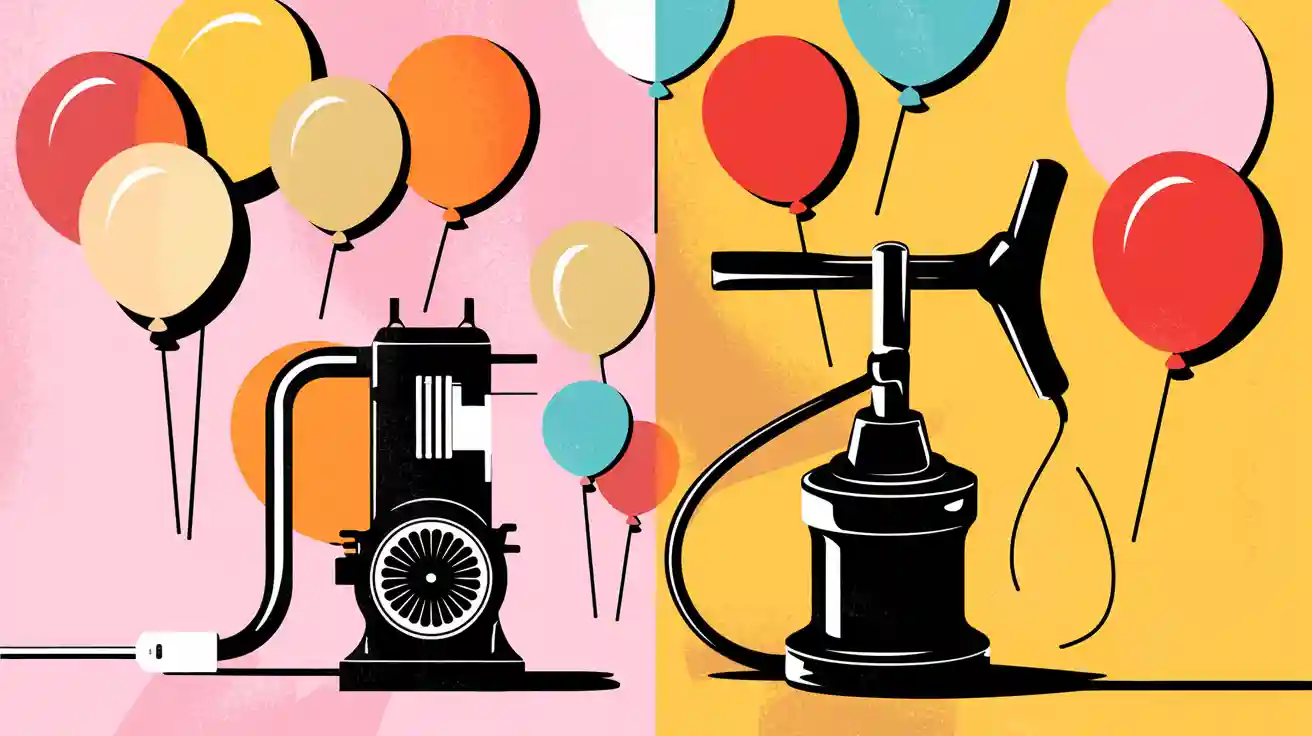
When it comes to inflating party balloons, selecting the right pump for balloons can save you both time and effort. An electric pump for balloons operates swiftly, inflating a balloon in roughly three seconds, making it an excellent choice for large events or frequent use. Conversely, a manual pump for balloons is lightweight, portable, and budget-friendly, making it ideal for smaller gatherings or outdoor occasions without access to power. If speed and convenience are your priorities, an electric pump for balloons is the perfect option. However, for those seeking affordability and portability, a hand pump for balloons might be the better choice. So, which pump for balloons suits your needs best?
Key Takeaways
Electric balloon pumps fill balloons in three seconds. They are great for big events when time matters.
Manual pumps are easy to carry and good for small parties or outdoor places without power.
Electric pumps save energy and help blow up many balloons easily. Manual pumps need more work and can make you tired.
Think about your money: manual pumps cost less, but electric pumps are worth it if you use them often, even though they cost more at first.
Pick what suits you: electric pumps are fast and efficient, while manual pumps are handy and simple to use anywhere.
Efficiency and Speed
Time to Inflate Balloons
When it comes to speed, an electric balloon pump outshines its manual counterpart. You can inflate a balloon in just three seconds with an electric pump. In contrast, a double-action manual pump requires about ten pumps to achieve the same result. This difference becomes even more noticeable when inflating multiple balloons.
Number Of Balloons | |
|---|---|
50 | 10 mins |
100 | 20 mins |
150 | 30 mins |
200 | 40 mins |
250 | 50 mins |
300 | 1 hour |
If you are preparing for a large event, the time saved by using an electric balloon pump can be significant. This efficiency makes it a preferred choice for event planners and decorators.
Effort Required
Using a manual balloon pump demands physical effort. You need to squeeze or pump repeatedly, which can lead to fatigue, especially when inflating a large number of balloons. On the other hand, an electric balloon inflator requires minimal effort. You simply press a button, and the pump does the work for you. This ergonomic design reduces strain and makes it easier to handle big tasks. If comfort is a priority, an electric pump is the better option.
Tip: For smaller gatherings, a manual pump might suffice. However, for larger events, the reduced physical effort of an electric pump can make a big difference.
Handling Large Quantities
Inflating hundreds of party balloons manually can be exhausting and time-consuming. An electric balloon pump simplifies this process. Many models come with dual nozzles, allowing you to inflate two balloons simultaneously. Some even offer automatic modes for consistent inflation. This feature ensures that all balloons are evenly filled, giving your decorations a professional look.
Electric pumps inflate balloons in seconds, saving you hours of preparation time.
They provide consistent results, ensuring uniformity in your decorations.
Their ergonomic design minimises physical strain, making them ideal for large-scale events.
If you need to create elaborate balloon decorations or handle large quantities, an electric pump for balloons is the most efficient choice.
Ease of Use
Simplicity of Operation
Electric balloon pumps are designed for ease of use, making them a popular choice among users. With just the press of a button, you can inflate balloons quickly and effortlessly. Many models include features like dual nozzles, allowing you to inflate two balloons at once. Automatic modes ensure consistent inflation, which simplifies the process further. These features make electric pumps ideal for those who value speed and efficiency.
In contrast, a hand pump requires manual effort and a bit of practice. You need to position the balloon correctly on the nozzle and pump repeatedly to achieve the desired inflation. While this process is straightforward, it can become tedious when inflating multiple balloons. For smaller gatherings or occasional use, a manual pump may still be a practical option.
Physical Comfort
Using an electric balloon inflator significantly reduces physical strain. Its ergonomic design allows you to inflate balloons without exerting much effort. Hands-free operation in some models adds to the convenience, making it suitable for extended use. This comfort is especially beneficial when preparing for large events.
On the other hand, manual pumps demand continuous effort. Repeated pumping can lead to hand fatigue or cramping, particularly when inflating a large number of balloons. Beginners may also struggle with proper positioning, which can add to the discomfort. If physical comfort is a priority, an electric pump for balloons is the better choice.
Beginner vs. Professional Use
Beginners often find electric pumps easier to use due to their simplicity and efficiency. Features like automatic inflation and consistent results eliminate the guesswork, making them user-friendly. Professionals, such as event decorators, also prefer electric pumps for their ability to handle large quantities quickly.
Manual pumps, however, may pose challenges for beginners. Common issues include hand fatigue, air leakage, and difficulty achieving a proper valve fit. The table below highlights some of these challenges:
Challenge | Description |
|---|---|
Manual Effort Required | Requires continuous manual pumping, which may cause hand fatigue over time. |
Valve Fit Issues | Some inflatables may need extra effort for a proper valve fit to avoid leaks. |
Learning Curve | Users may need time to learn the best technique for effective pumping. |
Potential for Air Leakage | Improper use can lead to air leakage, reducing inflation efficiency. |
Hand Cramping | Extended use might result in discomfort or cramping in the hands. |
Requires Proper Positioning | Correct positioning is essential for optimal inflation efficiency. |
For professionals or those handling large events, electric pumps are the preferred choice. However, if you are a beginner looking for a cost-effective option, a manual pump can still meet your needs with a bit of practice.
Portability and Convenience

Size and Weight
When considering portability, the size and weight of a balloon pump play a crucial role. Manual pumps are typically smaller and lighter than electric ones. You can easily carry them in a bag or even hold them in your hand. This compact design makes them ideal for travel or small gatherings.
Electric pumps, while slightly bulkier, are still designed with portability in mind. Many models feature a compact build that allows you to transport them without much hassle. However, their added weight and size may make them less convenient for on-the-go use compared to manual pumps. If portability is your top priority, a manual pump might be the better choice.
Power Needs
Electric balloon pumps require a power source to operate. Most models run on a voltage of 110V with a power rating of around 600W. This means you need access to an electrical outlet to use them effectively. While their compact design enhances portability, the reliance on electricity can limit their usability in certain settings.
Manual pumps, on the other hand, do not require any power source. You can use them anywhere, whether indoors or outdoors, without worrying about finding an outlet. This independence from electricity makes manual pumps a more versatile option for various locations.
Tip: If you plan to use your pump in areas without reliable access to electricity, a manual pump is the more practical choice.
Outdoor and Remote Use
For outdoor or remote events, manual pumps are often the preferred option. Their small size and lack of power requirements make them easy to carry and use in any setting. You can inflate balloons immediately without needing to return to a power source.
Electric pumps, while convenient, depend on electricity. This dependency makes them less suitable for remote locations or outdoor setups far from outlets. If you need to inflate balloons in such areas, a manual pump offers greater flexibility.
To summarise, manual pumps excel in portability and adaptability, especially for outdoor and remote use. Electric pumps, though more efficient, may face limitations in these scenarios due to their power needs. Choosing between the two depends on your specific requirements and event location.
Cost and Budget
Price Comparison
When choosing a balloon pump, cost plays a significant role. Manual pumps are the most affordable option, rarely exceeding £10. Electric balloon pumps, however, typically range from £20 to £40. If you opt for a professional-grade electric pump, the price can climb to £50 or more.
Type of Pump | Price Range |
|---|---|
Manual Balloon Pump | Up to £10 |
Electric Balloon Pump | £20 – £40 |
Professional Electric Pump | £50 or more |
Electric pumps can cost more than five times the price of manual ones. Professional models may even be twenty times as expensive. If you are working with a tight budget, a manual pump offers excellent value for money.
Long-Term Value
While manual pumps are cheaper upfront, electric pumps can provide better long-term value for frequent use. If you often host events or work in decorating, the time and effort saved by an electric pump justify the higher initial cost. For occasional use, though, a manual pump remains a cost-effective choice.
Type of Pump | Cost Comparison |
|---|---|
Manual Balloon Pump | Significantly cheaper than electric pumps |
Electric Balloon Pump | Can be more than 5 times the cost of manual pumps |
Professional Electric Pump | Can be upwards of 20 times the cost of manual pumps |
Consider how often you will use the pump. For frequent decorators or event planners, the efficiency of an electric pump outweighs its higher price.
Maintenance Costs
Manual pumps require little to no maintenance. Their simple design ensures durability, and you won’t need to worry about repairs or replacements for years. Electric pumps, on the other hand, involve additional costs. Over time, you may need to replace parts or repair the motor. Professional-grade models, while durable, can incur higher maintenance expenses.
If you prefer a low-maintenance option, a manual pump is the better choice. However, if you prioritise efficiency and are willing to invest in upkeep, an electric pump offers unmatched convenience.
Tip: Think about your long-term needs and budget when deciding which balloon pump is better for you.
Suitability for Different Scenarios
Personal Use
For personal use, a manual balloon pump offers several advantages. Its compact size and lightweight design make it easy to store and carry. You can use it without electricity, making it ready to go anytime. This pump is also cost-effective, providing excellent value for inflating party balloons, sports balls, or pool floats. Its dual-action efficiency allows you to inflate on both in and out strokes, saving time and effort.
Advantage | Description |
|---|---|
Dual Action Efficiency | Inflates on both in and out strokes for quick inflation. |
Compact and Portable | Small size and lightweight design for easy storage and travel. |
Cost-Effective | Affordable pricing providing excellent value for various inflatables. |
Versatile Use | Suitable for inflating balloons, sports balls, pool floats, and more. |
No Power Needed | Operates without electricity or batteries, ready to use anytime. |
Lung Saver | Reduces physical exertion and lung strain when inflating multiple balloons. |
Wide Compatibility | Works effectively with different types and sizes of balloons and inflatables. |
Ease of Use | Simple manual operation makes it user-friendly for beginners. |
Durable Construction | Built to withstand repeated use without performance degradation. |
Efficient for Small Tasks | Ideal for quickly inflating smaller objects at parties or events. |
If you need a reliable and portable option for occasional use, a manual pump is the perfect choice.
Parties and Events
Electric balloon pumps excel in party decorating and large-scale events. These pumps inflate balloons in seconds, saving you valuable time. You can focus on other tasks, such as arranging decorations or engaging with guests. Their consistent inflation ensures uniform balloon sizes, giving your decorations a polished and professional look.
Save Time: Inflating balloons manually is time-consuming; electric pumps can inflate them in seconds.
Focus on Other Tasks: With an electric pump, you can dedicate more time to decorating or engaging with guests.
Consistent Decoration: Electric pumps provide uniform balloon sizes, ensuring polished decorations.
Additionally, many electric pumps feature ergonomic designs and multiple nozzle attachments. These features allow you to inflate various balloon types effortlessly. If you are hosting a large event, an electric pump is an invaluable tool for creating stunning decorations quickly and efficiently.
Travel Needs
When travelling, portability becomes a key factor. A manual balloon pump is ideal for inflating balloons on the go. Its compact and lightweight design makes it easy to carry in your bag. Unlike electric pumps, it does not require a power source, allowing you to use it anywhere. Whether you are at a remote location or an outdoor event, a manual pump ensures you can inflate balloons without hassle.
The Hand Air Pump for Balloons is a great example of a travel-friendly option. Its simple design and versatility make it suitable for various inflating needs. If you prioritise portability and convenience, a manual pump is the best choice for travel.
Choosing the right pump for balloons depends on your specific needs. Electric balloon pumps excel in speed and efficiency, making them ideal for large-scale events or frequent use. They inflate balloons in seconds and reduce physical strain, but they require access to power and can be noisy. Manual pumps, on the other hand, are affordable, portable, and perfect for occasional use or outdoor settings without electricity. To decide which balloon pump is better, consider factors like your budget, event size, and how often you’ll use it.
FAQ
1. Can you use an electric balloon pump for helium balloons?
No, electric balloon pumps are designed for air, not helium. You cannot use them to fill helium balloons. Helium requires specialised tanks or services. Electric pumps are ideal for inflating latex or foil balloons with air.
2. How noisy are electric balloon pumps?
Electric balloon pumps produce some noise during operation. The noise level depends on the model. Most pumps are not excessively loud, but you may notice a hum or whirring sound. If noise is a concern, check product reviews before purchasing.
3. Do manual pumps work with all balloon types?
Yes, manual pumps are compatible with most balloon types, including latex and foil. However, inflating larger or thicker balloons may require more effort. Ensure the pump nozzle fits the balloon opening securely for effective inflation.
4. How long does an electric pump last?
The lifespan of an electric balloon pump depends on its build quality and frequency of use. High-quality models can last several years with proper care. Avoid overloading the pump or using it continuously for extended periods to prolong its life.
5. Are manual pumps suitable for children?
Yes, manual pumps are safe and easy for children to use under supervision. They are lightweight and require no electricity, making them a child-friendly option for small parties or activities. Ensure children understand how to use the pump correctly to avoid damage.






One thought on “Pump for Balloons: Electric or Manual?”
Pingback: Electric or Manual Balloon Pumps Which Is Better – Chaoee